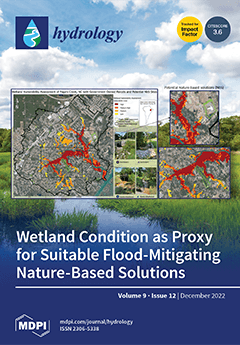Globally, more than 50 million ha of arable land is irrigated with saline water. The majority of this saline irrigation water is derived from saline groundwater. Global irrigation requirements may increase from 270 million ha in 2014 to about 750 million ha by 2050 as the global population increases to 9.1 billion people. The majority of this additional irrigation water is likely to come from saline groundwater sources. Desalination of irrigation water increases crop yield. A combination of high water volume requirements and low crop yields requires that, for widespread usage, the desalinated irrigation water product will require a delivery price of <USD 0.5 m
3. This study considers five passive desalination routes (n-Fe
0; n-Fe
3O
4; Fe
0:Fe(b)@C
0 polymer; n-Fe
0:Fe(b) polymer; n-Fe(b) polymer) that may potentially achieve this goal: A common desalination mechanism is identified for the Fe
0:Fe(b)@C
0 polymer; n-Fe
0:Fe(b) polymer; and n-Fe(b) polymer routes. The analysis establishes that the n-Fe(b) polymer route may be able to achieve (with a reaction time of 1 h) an 80% to 90% desalination of saline groundwater or flowback water (12.3 g NaCl L
−1; EC = 17.6 dSm
−1), to form partially desalinated irrigation water (1.2 to 2.4 g NaCl L
−1; EC = 2 to 3.4 dSm
−1) with an associated reduction in the sodium adsorption ratio (SAR) from 125 to between 1.2 and 2.5, for a potential material (n-Fe(b) polymer) treatment cost of <USD 0.01 m
−3, after considering polymer reuse and recycle, but excluding all other plant and other operating costs. The examples demonstrate that the polymers can be used to create: (i) a desalinated stationary hydrodynamic plume, containing 47,123 m
3 water (1 to 2.5 g NaCl L
−1), within 157,080 m
3 porous rock forming a confined, saline aquifer (18.59 g NaCl L
−1), to act as a reservoir of desalinated water (96 m
3 d
−1) for irrigation, with the potential to produce >960 m
3 d
−1 as required; (ii) a desalinated, perched, stationary, shallow groundwater mound, located above the regional water table, containing >200 m
3 of desalinated water.
Full article





